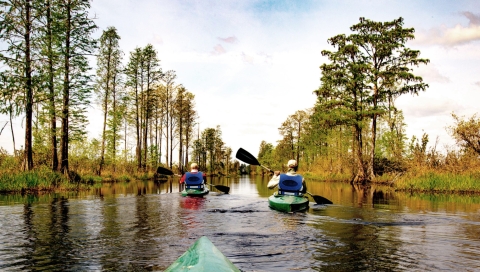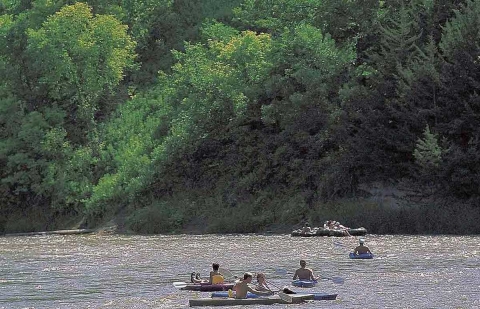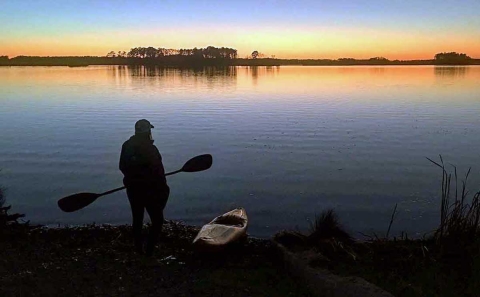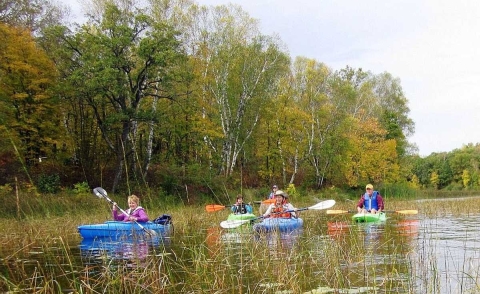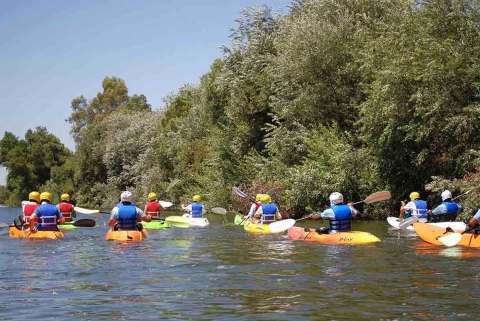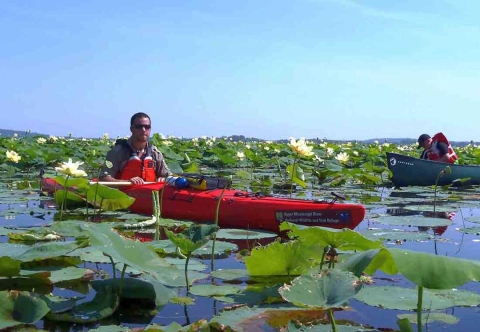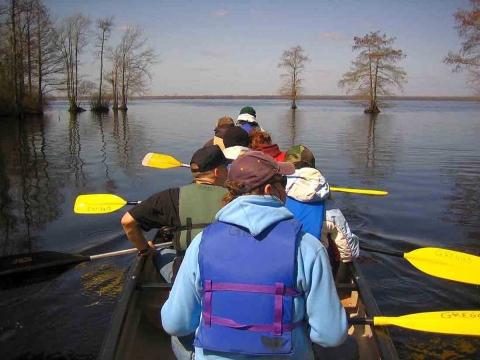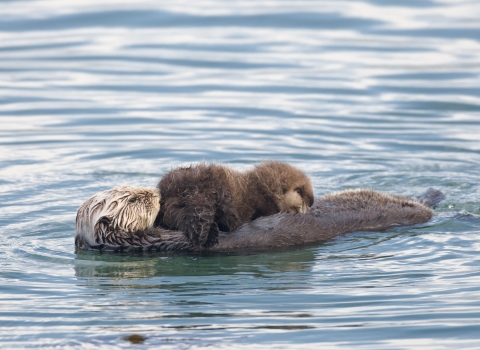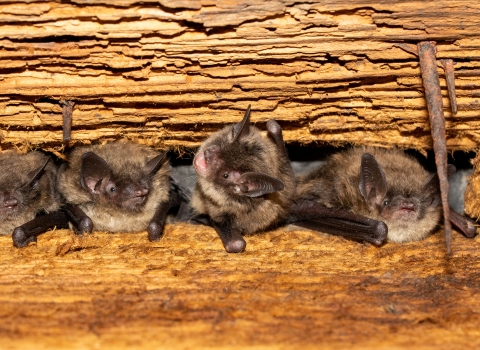Whether you’re in a canoe, a kayak or a rowboat, propelling yourself through waters in unspoiled nature is physically and spiritually exhilarating. It’s a wonderful way to spend a few hours outdoors – with friends or by yourself. Come along as we tour a sampling of national wildlife refuges across America that offer just that experience.
Okefenokee National Wildlife Refuge is one of the finest places in the nation to paddle.
Sunrise and sunset are magical times of day at the refuge, when brilliantly colored rays of light shine through longleaf pines and reflect on still, tannic water, says ranger Susie Heisey.
As you paddle the refuge’s cypress swamp and wet prairie, you might see alligators, river otters, white ibis, red-shouldered hawk, barred owl, sandhill cranes, great blue herons and prothonotary warblers.
You don’t have to own a boat to paddle on national wildlife refuges. Usually, there are places nearby to rent canoes or kayaks.
At Okefenokee, rentals are available inside the refuge’s main entrance on the east and at Stephen C. Foster State Park on the west.
Siletz Bay National Wildlife Refuge is along the coast, but the bay protects paddlers from Pacific Ocean waves and winds.
“During the paddle, you pass along salt marsh salt marsh
Salt marshes are found in tidal areas near the coast, where freshwater mixes with saltwater.
Learn more about salt marsh , mudflats, sea grass beds and sheltered channels that form a complex tapestry of habitats characteristic of estuaries where rivers meet the sea,” wrote former intern Peter Pearsall. “The wildlife are also in constant flux, from amphibians metamorphosing in bogs and resident birds donning breeding plumage in spring to spawning salmon – born in freshwater and raised in saline depths – forming rivers of flesh that pour upstream from the sea.”
Autumn is a great time to be on the water, says visitor service manager Dawn Harris. It’s still warm out, tidal waters are calm, and fall colors cover the mountains and hills.
At least two businesses in Lincoln City rent kayaks and canoes.
People need a place that makes them feel “inspired anew with the wonder and pure majestic beauty of Mother Nature,” wrote blogger Bruce Tomes. “The Niobrara River in Nebraska is that place for me.”
The river flows through Fort Niobrara National Wildlife Refuge in a deep canyon that encompasses a national wilderness area wilderness area
Wilderness areas are places untamed by humans. The Wilderness Act of 1964 allows Congress to designate wilderness areas for protection to ensure that America's pristine wild lands will not disappear. Wilderness areas can be part of national wildlife refuges, national parks, national forests or public lands managed by the Bureau of Land Management.
Learn more about wilderness area and a nationally designated scenic river and recreation trail.
“One can easily see American redstart, common yellowthroat, belted kingfisher and yellow warblers,” says refuge manager Steve Hicks. “If you are quiet and look closely, you might see very large spiny softshell turtles sunning themselves along the shore.”
Spring, summer or fall all are all great times to float the river. Dawn and dusk typically offer the best wildlife-viewing opportunities. Weekdays are less crowded than weekends. “Let the river take you on an easy float,” says Hicks. “Relax, take your time, and enjoy the ride.”
At least nine commercial outfitters in or near Valentine, Nebraska, provide canoe, kayak or float trips on the river.
“I love evening paddles, with the sun setting on the horizon, all the reds and yellows, and the sound of the birds roosting for the night,” says Blackwater National Wildlife Refuge manager Marcia Pradines. “The Green Trail is my favorite, and is open year-round. Bald eagles are extremely common. We have the largest population on the East Coast, north of Florida. No matter how often you see them, they are still impressive. Osprey are also very common, and you are likely to see one grab lunch right in front of your bow. I also love sneaking up on the painted turtles basking along the banks.”
The refuge is a hub of outdoor recreation in Dorchester County, Maryland. At least two businesses in nearby Cambridge rent boats.
“The coolest thing about paddling on Kenai National Wildlife Refuge is that there are so many high-quality options,” says refuge ranger Leah Eskelin. “Visitors can find easily accessible roadside lakes to explore for a couple hours, or spend a week or more on backcountry wilderness trips within the Kenai Refuge Canoe System. Paddling on any of the smaller lakes offers a great way to see wildlife that is harder to see from the roadside.”
Water trails cover more than 100 miles on the almost -2-million-acre refuge.
“My favorite place for a day canoe trip is into Swan Lake,” says retired supervisory ranger Candace Ward. “It takes about three hours of paddling on small lakes and portaging between them to reach this beautiful lake that has a grand view of the Kenai Mountains. I have always been treated to, at a minimum, watching loons and grebes and have also seen moose and occasionally land otters and trumpeter swans.”
Bald eagles, beavers and black bears are common, too.
“While there may be 10,000 lakes to choose from in Minnesota, Tamarac National Wildlife Refuge offers a uniquely pristine experience on the water,” says visitor services manager Kelly Blackledge. “There are no houses on the shore, and you are miles away from any noisy highway. The lakes on the refuge are surrounded by forests that protect the waters from wind. After you slide your canoe or kayak into the water, you can glide through the early morning mist or gaze at the reflection of clouds and evening sunset rays that stretch across the still water.”
Early September is Blackledge’s favorite time to paddle on the refuge: “I like to launch on the south side of Tamarac Lake and paddle around the island and through stands of wild rice. During the summer months Blackbird and Two Island Lakes provide wonderful views of eagles soaring above and secret paths to the biggest beaver lodges you’ll ever see.” All the while, she says, you’re “listening to the calls of swans and loons.”
Canoes and kayaks can be rented from at least one business in Detroit Lakes, Minnesota, 17 miles from the refuge visitor center.
Upper Klamath National Wildlife Refuge sits at the base of snow-capped Mount McLaughlin in the heart of the Oregon’s scenic forested backcountry. “It is the perfect backdrop for a canoe trail, ideal for viewing abundant wildlife or pondering the intrinsic beauty of Oregon’s largest natural lake,” say visitor services manager John Fitzroy.
The Upper Klamath Canoe Trail provides a marked, 8.5-mile journey through a large freshwater marsh. The canoe trail has four segments – each offering a distinct look at the marsh.
The trail can be accessed from the Rocky Point or Malone Springs boat launches. Canoes can be rented at Rocky Point. Check with the refuge about guided canoe tours offered from April to September.
May is a great month to see migratory birds, Fitzroy says. You’re also likely to see otters, bald eagles, swans and herons.
The SoCal Urban Wildlife Refuge Project reaches deep into Los Angeles, where the revitalization of the L.A. River is bringing back nature to city residents. The project is coordinated through the San Diego National Wildlife Refuges and works to nurture conservation from Santa Barbara and Ventura, north of L.A., to the Mexican border, south of San Diego. Dozens of partners in the project include the L.A. Conservation Corps and the Friends of the Los Angeles River.
Check out this five-minute video for more about community wildlife conservation in Southern California.
Mark Twain wrote that the Mississippi River “is in all ways remarkable.”
There are three dozen national wildlife refuges along the river in 10 states from its source in Minnesota to its mouth in Louisiana. Most have paddling possibilities.
Upper Mississippi River National Wildlife and Fish Refuge alone has 96 miles of marked canoe trails, rated by difficulty. Pick a trail that matches your skill level.
When paddling on a national wildlife refuge national wildlife refuge
A national wildlife refuge is typically a contiguous area of land and water managed by the U.S. Fish and Wildlife Service for the conservation and, where appropriate, restoration of fish, wildlife and plant resources and their habitats for the benefit of present and future generations of Americans.
Learn more about national wildlife refuge , remember to follow all state and local boating regulations. And follow these Top 10 Safety Tips from the American Canoe Association.


